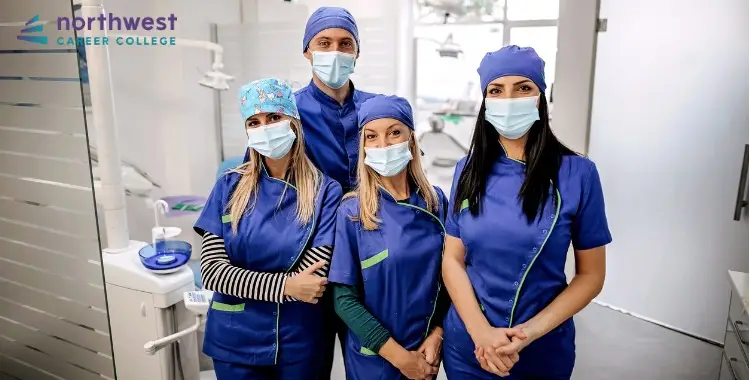The Medical Assistant’s Guide to Managing Medical Emergencies – Part 1
- Medical Assistant
- March 12, 2024
- 3.0k views
- 5 min read

Although many patients may not think about it when not in a hospital setting, quickly identifying and effectively assisting with medical emergencies is critical to a medical assistant’s job responsibilities.
On any given day, a trip to a medical office for a check-up or specialty testing can seem pretty routine… even dull. However, every medical practice, and therefore every medical assistant, must ensure they understand each patient’s unique medical needs and can recognize the signs of common medical emergencies.
In this multi-part article series, we will explore a few of the most prominent examples of medical emergencies that medical assistants need to be prepared to identify and help manage. However, before we do, we will explore some of the basic knowledge and principles that a medical assistant must be able to apply in all emergencies.
Read More: Important Role Of The Medical Assistant
Table of Contents
Identifying Medical Emergencies
Quickly identifying a medical emergency is the most essential way a medical assistant can help prevent a long-term negative outcome for their patients. Awareness is critical, as medical assistants must be adept at recognizing common emergencies. Examples include respiratory distress, cardiac issues, and allergic reactions.
We will explore each of these in greater detail in coming articles. In all cases, medical assistants must always pay attention to their patients when in the office, actively listen if they are reporting something unusual, and be aware of their emergency response training to know all the steps needed to handle various emergencies.
In healthcare practices, it’s not uncommon to encounter emergencies. For instance, in specific settings like family medicine, urgent care, and pediatric facilities, urgent care, cases can be seen weekly or even daily. Medical assistants will develop proficiency and confidence in handling the medical emergencies most commonly seen in their unique healthcare setting.
Emergency Equipment and Supplies
Hand-in-hand with paying attention to their patients and being aware of the signs of common medical emergencies, it is essential that medical assistants know where the emergency kit is inside their office and know how to use its contents.
Emergency supplies include basic first aid supplies, epinephrine auto-injectors, glucose paste, emergency inhalers, and nitroglycerin. Depending upon your facility, these will likely be used at different frequencies, but the office must be prepared to use all of them at a moment’s notice.
In addition to being familiar with the location of the emergency kit(s), it is typically a medical assistant’s job to ensure that all supplies in the kit are well-stocked and that none have been allowed to expire. Most medical practices have a routine to check their kits once every quarter or every six months to ensure that they never run out of an essential item or that a critical item does not expire before fresh materials are re-ordered and received.
Procedures and Protocols
Every medical office is slightly different, but one thing they all have in common is that healthcare facilities have established procedures for different types of emergencies. Medical assistants must prioritize learning the emergency protocols for their office soon after they are hired into their facility since it is impossible to predict when this knowledge will be needed.
Medical assistants should know their potential role(s) in various emergencies. This may include assisting with medication, administration, or calling emergency services. In any case, as mentioned above, it is vital that early identification of the emergency occurs and that the licensed healthcare provider is informed as soon as reasonably achievable so that they can manage the facility’s response to the emergency.
Given the wide range of potential emergencies, the importance of a medical assistant being familiar with their office’s emergency protocols cannot be understated.
Communication and documentation
During emergencies, clear communication among staff members is critical. A well-documented phenomenon is that when somebody says something needs to occur to a large group of people in an emergency, most assume someone else will do it, and no one takes action. That is why it is so critical that the person managing an emergency response assigns specific tasks to specific team members so that they can be sure everything gets done.
For example, when a patient experiences cardiac arrest, and CPR is needed, one person must manage the response and deliver CPR, one person will call emergency services, one person will get the AED, and another person may assist with two-person CPR (if available). If the person managing the situation does not communicate these roles, then the CPR may not be effectively delivered, reducing the likelihood that a patient can be resuscitated.
Every medical emergency has examples like this; the takeaway is that communication must be clear throughout a medical emergency.
Additionally, accurate documentation is critical after the conclusion of the emergency response. Documenting the incident accurately is vital for legal and medical recordkeeping. Not only is it essential for medical assistants to document in a timely and comprehensive manner for their protection, it is also for the protection of the medical practice where they work and for the patient’s safety in case they need follow-up care at an emergency facility such as a hospital.
Conclusion
Medical assistants play a pivotal role in managing medical emergencies. Their continual awareness of the patient’s status, preparedness to identify the signs of a medical emergency, knowledge of equipment and emergency procedures for the office, and ability to communicate clearly with coworkers and the provider are all essential for patient safety and care in an urgent situation.
Regular emergency drills are recommended in medical offices to ensure that all team members are ready when the moment arises.
In upcoming articles, we will dive deeper into some of the most common medical emergencies that medical assistants must be prepared to manage. Stay tuned for more!





